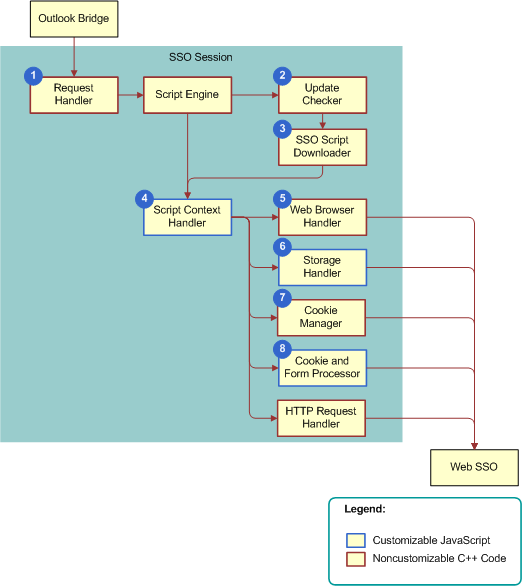Architecture That an SSO Session Uses
The following figure illustrates the architecture that an SSO session uses.

Explanation of Callouts
The architecture that an SSO session uses includes the following items:
Request handler. Accepts each request from the Outlook Bridge, wraps the request in an object that an SSO script can access, routes the request through SSO script, and then sends the reply from the SSO to the client. It initializes the script, registers the request handler to handle connector requests and initializes the request handler. For example, it reads configuration settings, initializes global variables, and so forth. It runs the function that the request handler code registers for callback. For each incoming connector request, the SSO script establishes or reuses an SSO session with the Siebel Server and sends a reply to this server. For more information, see Request Handler Function.
Update checker. Calls the SSO script that runs autoupdate. It does this work the first time this session uses this script. For more information, see Installing Siebel CRM Desktop SSO If You Use Autoupdate.
SSO script downloader. Downloads and prepares the SSO script.
Script context handler. Uses one instance of a Microsoft ActiveScript engine that runs SSO script and sends a reply to a request handler notification.
Web Browser handler. Displays an interactive login prompt to user, interprets the login information that this user enters, and notifies the SSO script.
Storage handler. Handles persistent and session storage.
Cookie manager. Gets and sets Internet Explorer cookies.
Cookie and form processor. Processes cookies, forms, and redirects. For more information, see Cookie Handling.
To customize the following items, you can reuse SSO objects or you can use your own set of common code. For more information, see Siebel CRM Desktop SSO Objects You Can Customize.
Script context handler
Storage handler
Cookie and form processor
You cannot use JavaScript to customize items in Architecture That an SSO Session Uses that use C++ code, but you can change registry settings that affect these items.